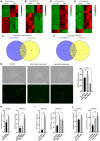Hydrogen sulfide treatment at the late growth stage of Saccharomyces cerevisiae extends chronological lifespan
- PMID: 33744847
- PMCID: PMC8064171
- DOI: 10.18632/aging.202738
Hydrogen sulfide treatment at the late growth stage of Saccharomyces cerevisiae extends chronological lifespan
Abstract
Previous studies demonstrated that lifelong treatment with a slow H2S releasing donor extends yeast chronological lifespan (CLS), but it is not clear when the action of H2S benefits to CLS during yeast growth. Here, we show that short H2S treatments by using NaHS as a fast H2S releasing donor at 96 hours after inoculation extended yeast CLS while NaHS treatments earlier than 72 hours after inoculation failed to do so. To reveal the mechanism, we analyzed the transcriptome of yeast cells with or without the early and late NaHS treatments. We found that both treatments had similar effects on pathways related to CLS regulation. Follow-up qPCR and ROS analyses suggest that altered expression of some antioxidant genes by the early NaHS treatments were not stable enough to benefit CLS. Moreover, transcriptome data also indicated that some genes were regulated differently by the early and late H2S treatment. Specifically, we found that the expression of YPK2, a human SGK2 homolog and also a key regulator of the yeast cell wall synthesis, was significantly altered by the late NaHS treatment but not altered by the early NaHS treatment. Finally, the key role of YPK2 in CLS regulation by H2S is revealed by CLS data showing that the late NaHS treatment did not enhance the CLS of a ypk2 knockout mutant. This study sheds light on the molecular mechanism of CLS extension induced by H2S, and for the first time addresses the importance of H2S treatment timing for lifespan extension.
Keywords: NaHS; Saccharomyces cerevisiae; aging; chronological lifespan; hydrogen sulfide.
Conflict of interest statement
Figures






Similar articles
-
Calorie restriction extends the chronological lifespan of Saccharomyces cerevisiae independently of the Sirtuins.Aging Cell. 2007 Oct;6(5):649-62. doi: 10.1111/j.1474-9726.2007.00326.x. Epub 2007 Aug 15. Aging Cell. 2007. PMID: 17711561
-
Gene-nutrient interaction markedly influences yeast chronological lifespan.Exp Gerontol. 2016 Dec 15;86:113-123. doi: 10.1016/j.exger.2016.04.012. Epub 2016 Apr 25. Exp Gerontol. 2016. PMID: 27125759 Free PMC article.
-
Effects of fast versus slow-releasing hydrogen sulfide donors in hypertension in pregnancy and fetoplacental growth restriction.Naunyn Schmiedebergs Arch Pharmacol. 2019 Dec;392(12):1561-1568. doi: 10.1007/s00210-019-01697-0. Epub 2019 Jul 30. Naunyn Schmiedebergs Arch Pharmacol. 2019. PMID: 31363805
-
Hydrogen sulfide and its roles in Saccharomyces cerevisiae in a winemaking context.FEMS Yeast Res. 2017 Sep 1;17(6). doi: 10.1093/femsyr/fox058. FEMS Yeast Res. 2017. PMID: 28830086 Review.
-
Yeast Chronological Lifespan: Longevity Regulatory Genes and Mechanisms.Cells. 2022 May 23;11(10):1714. doi: 10.3390/cells11101714. Cells. 2022. PMID: 35626750 Free PMC article. Review.
Cited by
-
Hydrogen Sulfide can Scavenge Free Radicals to Improve Spinal Cord Injury by Inhibiting the p38MAPK/mTOR/NF-κB Signaling Pathway.Neuromolecular Med. 2024 Jun 21;26(1):26. doi: 10.1007/s12017-024-08794-1. Neuromolecular Med. 2024. PMID: 38907170 Review.
-
The Activity of YCA1 Metacaspase Is Regulated by Reactive Sulfane Sulfur via Persulfidation in Saccharomyces cerevisiae.Antioxidants (Basel). 2024 May 10;13(5):589. doi: 10.3390/antiox13050589. Antioxidants (Basel). 2024. PMID: 38790694 Free PMC article.
-
Evidence for a hydrogen sulfide-sensing E3 ligase in yeast.Genetics. 2024 Nov 6;228(3):iyae154. doi: 10.1093/genetics/iyae154. Genetics. 2024. PMID: 39378345 Free PMC article.
-
Possible regulatory network and associated pathways governing the expression of ADH2 in Saccharomyces cerevisiae.Curr Genet. 2025 Aug 18;71(1):15. doi: 10.1007/s00294-025-01321-0. Curr Genet. 2025. PMID: 40824391 Review.
-
Neem Leaf Extract Exhibits Anti-Aging and Antioxidant Effects from Yeast to Human Cells.Nutrients. 2024 May 16;16(10):1506. doi: 10.3390/nu16101506. Nutrients. 2024. PMID: 38794743 Free PMC article.
References
-
- Moskalev A, Chernyagina E, de Magalhães JP, Barardo D, Thoppil H, Shaposhnikov M, Budovsky A, Fraifeld VE, Garazha A, Tsvetkov V, Bronovitsky E, Bogomolov V, Scerbacov A, et al.. Geroprotectors.org: a new, structured and curated database of current therapeutic interventions in aging and age-related disease. Aging (Albany NY). 2015; 7:616–28. 10.18632/aging.100799 - DOI - PMC - PubMed
Publication types
MeSH terms
Substances
LinkOut - more resources
Full Text Sources
Other Literature Sources
Molecular Biology Databases

